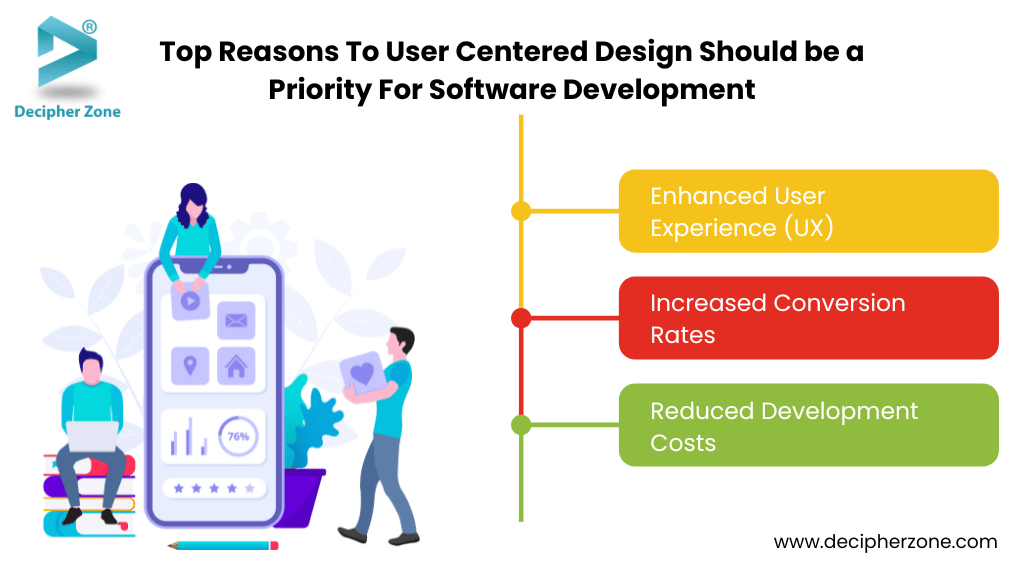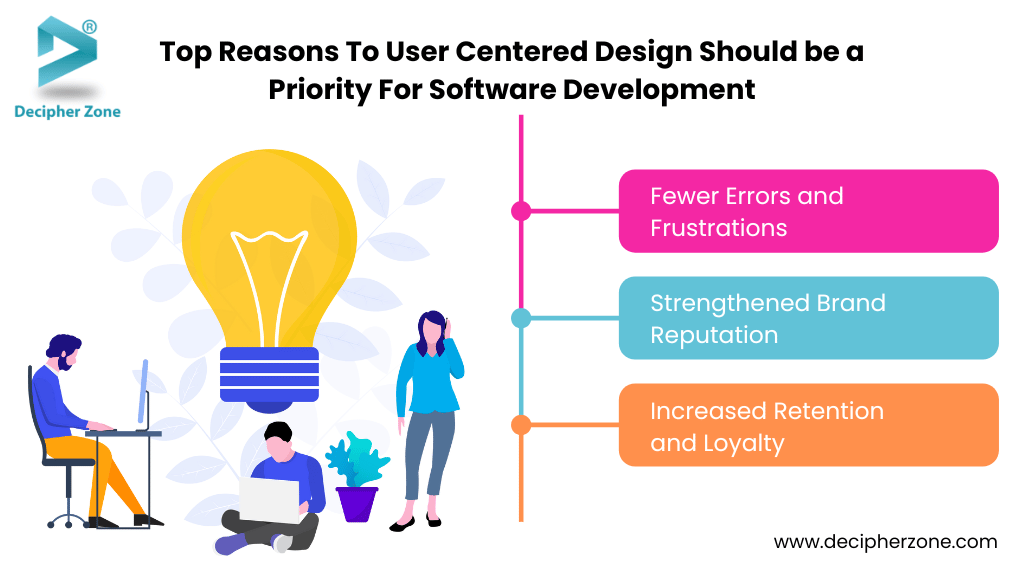The top reasons in detail why User centered design approach is crucial for software development companies and aims to provide top-notch services. This blog will help you build your software solution with high user satisfaction, and help you recognize the importance of user-centered design.
Think about it–would you revisit a restaurant where the service was slow, the menu was hard to understand, and your order completely missed the mark? Similarly, a poorly designed product feels just as frustrating, and users have no hesitation in walking away to find better alternatives.
Implementing a User Centered Design (UCD) can serve as the guiding force behind the digital experience, ensuring every aspect of the “menu” is tailored to meet the needs, preferences, and goals of the audience.
User-centered design is not just about making things look pretty, it’s a structured approach to creating solutions that truly resonate with the users, solving their problems efficiently and intuitively.
When you’re working on a website, an application, or even a physical product, having the user at the center of the design process is essential. It’s like having a map for your journey—it helps you stay on track and ensures you reach a destination that leaves users feeling delighted rather than disappointed. Embracing user-centered design is not just a luxury; it’s a necessity.
In this blog, you will explore why User-Centered Design should be a priority for businesses and developers alike. Along with the benefits it brings, the impact it has on your success, and how you can avoid common mistakes. Get ready to take your design from ordinary to extraordinary.
What is User Centered Design (UCD)?
At its heart, User Centered Design (USD) is a design philosophy and methodology that prioritizes the needs, behaviors, and goals of the end user throughout the product development process. UCD is all about putting the user first, not guessing what users want—crafting experiences that feel intuitive engaging, and purposeful.
Every measurement, every stitch, and every detail is fine-tuned to fit the wearer perfectly as UCD is designed as a custom-tailored suit—ensuring that every feature, layout, and interaction in a product is built with the user’s perspective in mind. But what makes UCD truly effective? It is grounded in a set of core principles that guide the entire process:
-
Involving users throughout the design process,
-
Focusing on Usability, Accessibility, and User Satisfaction,
-
Iterative Testing and Feedback Loops.
The power of UCD is that it is a mindset that transforms the way businesses think about their users, turning on-size-fits-all products into tailored solutions that resonate deeply. By understanding and embracing these principles, you can create experiences that not only meet user needs but also exceed their expectations.
6 Reasons To User Centered Design Should be a Priority For Software Development
For businesses aiming to create successful applications, the focus goes beyond simply crafting functional apps; it’s about providing outstanding user experiences that not only meet but also exceed expectations.
In this quest, User Centered Design (UCD) plays an essential role. By focusing on the needs, behaviors, and goals of end-users, UCD helps software development companies create intuitive, efficient, and impactful solutions. Here are the top reasons why prioritizing UCD is essential:
1. Enhanced User Experience (UX)
Think of User-Centered Design (UCD) as crafting a GPS that not only maps out the routes but also learns and adapts to traffic conditions and user preferences, ensuring each journey is smooth and stress-free.
Similarly, in software development, enhancing user satisfaction hinges on creating an intuitive interface, establishing logical workflows, and delivering seamless experiences. A strong UCD approach is essential for achieving this goal.
Prioritizing UCD for software development companies means,
-
Creating applications that feel natural to navigate without considering the user’s technical proficiency.
-
Reducing the learning curve for new users ensures that they can both quickly adapt to and adopt the software,
-
Delivering experiences that leave users delighted, driving loyalty and positive word-of-mouth recommendations.
2. Increased Conversion Rates
Whether it is encouraging more sign-ups for a SaaS product or driving sales on a eCommerce platform, UCD directly impacts the bottom line, when aligned with user expectations, engagement, and conversions.
How UCD boosts conversions:
-
Simplifies process, reducing friction at critical touchpoints like sign-up forms, checkout pages, etc.
-
Anticipates user needs that make interactions more rewarding.
-
Encourages users to complete actions by creating trust and satisfaction through thoughtful design.

3. Reduced Development Costs
Developing software without understanding user needs often leads to costly redesigns or feature overhauls later in the process. UCD addresses this challenge by identifying potential issues early, saving time and money.
Key cost-saving benefits of UCD:
-
Early user research helps avoid unnecessary features that don’t align with user goals.
-
Prototyping and iterative testing uncover pain points before full-scale development begins.
-
Reduces the risk of post-launch updates to fix usability problems, keeping projects within budget.
4. Fewer Errors and Frustrations
UCD minimizes the risks like frustrated users from poorly designed software, errors, inefficiencies, and tarnished reputation by creating systems that are user-friendly and error-resistant.
How UCD prevents frustrations:
-
Ensuring users don’t feel overwhelmed by simplifying the complex processes into manageable steps.
-
Incorporates feedback mechanism to catch errors and address them before widespread adoption.
-
Making sure that the users feel in control by providing clear instructions and error recovery options.
5. Strengthened Brand Reputation
A reputation for delivering user-friendly products for software development companies can set them apart from the competitive market. User centered design acts as a differentiator, demonstrating that the company values user satisfaction above all else.
Why UCD matters for branding:
-
Satisfied users share their experiences which leads to organic referrals and positive reviews.
-
Products designed with user-centered design principles establish trust which reinforces a company’s commitment to quality.
-
A portfolio of user-focused solutions positions the company as an industry leader.

6. Increased Retention and Loyalty
Software built with user-centered design encourages long-term loyalty by consistently delivering value and adapting to user needs as acquiring a new user is costly, but retaining one is invaluable.
Retention through User-Centered Design:
-
Regular updates based on user feedback show customers their voices matter.
-
Intuitive designs reduce the likelihood of users abandoning the software for competitors.
-
Continuous optimization ensures the software evolves alongside user demands.
With all the reasons, software development companies prioritize and still even with the best intentions, missteps can undermine user centered design efficiencies. The common pitfalls are ignoring user feedback, overcomplicating the design, and neglecting accessibility. Avoiding these errors is key to delivering a truly user-centered experience.
Final Thoughts
From enhancing user satisfaction to driving business success, User-centered design proves its worth by delivering long-term value for both users and companies alike. But here’s the truth: Great design doesn’t happen by accident.
It requires intentional empathy and a commitment to understanding your users. By prioritizing user centered design, you are not just creating software or services—you are crafting experiences that are intuitive, accessible, and deeply satisfying.
When selecting a software development company, prioritize those that focus on user needs and adopt a user-centered design approach.
By partnering with Decipher Zone, you can unlock the potential to delight your users and transform your business. Our expertise in creating custom software solutions puts user satisfaction at its core, ensuring a positive experience for everyone involved.

Frequently Asked
-
How can I implement User-Centered Design in my project?
Implementing user centered design requires thorough research through various interviews, surveys, and observations, needing professionals to perform the steps with their expertise and experience to evaluate valuable insights. To achieve the desired outcome certain steps are involved, from research to creating a roadmap, to brainstorming to prototyping testing, to aligning expectations, to embracing iterative feedback loops, to delivering intuitive and seamless experiences. Remember, UCD is not a one-time task; it’s a mindset that evolves with your users’ needs.
-
What are the common mistakes when using User-Centered Design?
software development companies prioritize and still even with the best intentions, missteps can undermine user centered design efficiencies. The common pitfalls are ignoring user feedback, overcomplicating the design, and neglecting accessibility. Avoiding these errors is key to delivering a truly user-centered experience.
-
Can User-Centered Design save me money in the long run?
Yes, user-centered design reduces support costs by creating intuitive designs that minimize confusion and errors and prevent constant redesigns down the road. However, user centered design is not just about saving money, it is about creating a product that drives satisfaction, loyalty, and profitability that ensures long-term success.

